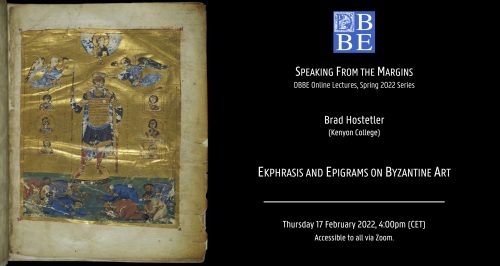The first lecture in the online lecture series Speaking From the Margins. DBBE Online Lectures, Spring 2022 Series will be given by Brad Hostetler (Kenyon College).
Brad Hostetler is Assistant Professor of Art History at Kenyon College. He specializes in the art and material culture of Late Antiquity and Byzantium, with a particular emphasis on portable luxury objects from the ninth through the twelfth centuries. His research focuses on the relationships between texts and images, including ekphraseis about, and words inscribed on, works of art. He is currently working on a book that examines the nature and meaning of relics and reliquaries in Byzantium through the lens of inscriptions, including the ways in which inscribed texts mediate and guide the faithful’s engagement with, and understanding of, sacred matter. Brad’s work has been supported by grants and fellowships from the Gladys Krieble Delmas Foundation, Dumbarton Oaks Research Library and Collection, and the Metropolitan Museum of Art.
Abstract
The term “ekphrastic epigram” has been used to denote verse inscriptions that describe works of art. But, as has been demonstrated, this term is a misnomer as these poems are not technically ekphraseis. Prose was traditionally the medium of choice for ekphraseis; the need to achieve the vividness of speech was more difficult in verse, given its metrical constraints. Inscribed epigrams therefore presented a double challenge in that they also constrained the writer to a limited number of verses that could be displayed on the object. As Marc Lauxtermann observes, epigrams inscribed on works of art are too short to elaborate on the “emotional depth and narrative width” that is required to develop ekphrastic themes.
While I agree with this assessment, I also suggest that Byzantine epigrams on works of art do exhibit some characteristics of ekphrasis, albeit in a much more abbreviated form. In this paper, I examine these features, and show the ways in which some inscribed epigrams possess rhetorical properties that are similar to those required for literary ekphraseis. Just as Nicholas Mesarites, for example, led the listener/viewer beyond the facts of the images in the Church of the Holy Apostles, and challenged his audiences’ perception of the mosaics through vivid description, so too do the poets of inscribed epigrams open up their descriptions to help the viewer consider their perceptions of objects.
Practical information
Date & time: Thursday 17 February 2022, 4:00pm (CET)
No registration required. The lecture is freely accessible via Zoom: https://ugent-be.zoom.us/j/96375525205?pwd=Q2Y4L2tRQ2VVakEzUXJta1NVVGpudz09.
- Meeting ID: 963 7552 5205
- Passcode: 750inUfB
N.B.: A Zoom account is required to join this meeting. Please make sure to be logged in, using your Zoom credentials.
